
The Project Gutenberg EBook of Saratoga National Historical Park, New York, by
Charles W. Snell and Francis F. Wilshin
This eBook is for the use of anyone anywhere in the United States and most
other parts of the world at no cost and with almost no restrictions
whatsoever. You may copy it, give it away or re-use it under the terms of
the Project Gutenberg License included with this eBook or online at
www.gutenberg.org. If you are not located in the United States, you'll have
to check the laws of the country where you are located before using this ebook.
Title: Saratoga National Historical Park, New York
National Park Service Historical Handbook Series No. 4
Author: Charles W. Snell
Francis F. Wilshin
Release Date: January 25, 2018 [EBook #56428]
Language: English
Character set encoding: UTF-8
*** START OF THIS PROJECT GUTENBERG EBOOK SARATOGA NATIONAL HISTORICAL PARK ***
Produced by Stephen Hutcheson and the Online Distributed
Proofreading Team at http://www.pgdp.net


UNITED STATES DEPARTMENT OF THE INTERIOR
Fred A. Seaton, Secretary
NATIONAL PARK SERVICE
Conrad L. Wirth, Director
HISTORICAL HANDBOOK NUMBER FOUR
This publication is one of a series of handbooks describing the historical and archeological areas in the National Park System, administered by the National Park Service of the United States Department of the Interior. It is printed by the Government Printing Office and may be purchased from the Superintendent of Documents, Washington 25, D. C. Price 25 cents.
by Charles W. Snell and Francis F. Wilshin
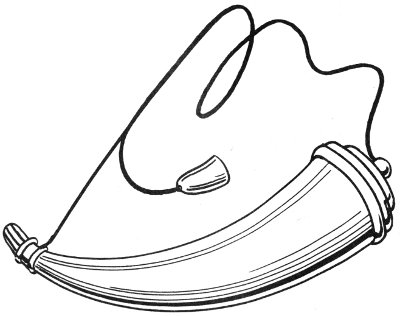
National Park Service Historical Handbook Series No. 4
Washington 25, D.C., 1950
(Revised 1959)
504451 O-59-2
REVISED 1959 U.S. GOVERNMENT PRINTING OFFICE: 1959 OF—504451

The National Park System, of which Saratoga National Historical Park is a unit, is dedicated to conserving the scenic, scientific, and historic heritage of the United States for the benefit and inspiration of its people.

Looking east from the site of the Balcarres Redoubt. The immediate foreground was the scene of desperate fighting in both battles of Saratoga. Scouts signaled the movements of Burgoyne’s army from Willard Mountain in the left distance. Courtesy Life Magazine.

Few battles in world history have had a more stirring climax than Saratoga and probably none have had more far-reaching consequences. Here, a ragged but inspired rebel army convincingly demonstrated its ability to rise to brilliant victory after absorbing staggering blows. In dramatic fashion Saratoga not only rescued the colonists from almost certain defeat, but also pointed significantly to the fate which likely would befall any enemy force penetrating into the interior of America and operating independently of the sea.
Abroad, the battles served immeasurably to increase the military prestige of American arms, while at home they greatly strengthened the fighting morale and discouraged loyalist opposition. In their broad aspects the two battles of Saratoga may be considered to mark definitely the turning point of the American Revolution in that the result brought to the cause of the hard-pressed colonists the assistance of France, Spain, and Holland, thereby greatly increasing the probability of eventually winning independence. To a hesitant, vacillating France awaiting the opportune moment to strike a telling blow at the British, Saratoga brought the decision for intervention—a decision which previous diplomatic negotiations had been unable to obtain. The active entrance of France into the war in June 1778, provided the financial, military, and naval support without which the American cause would have been practically hopeless. Though three more years of fighting were necessary in order to bring ultimate victory at Yorktown, Saratoga furnished the physical and psychological impetus which brightened a desperate cause at a moment when failure would have been disastrous. Without the success of American arms at Saratoga, it is difficult to see how the struggle could long have been continued.
Writing of the significance of Saratoga, Sir Edward Creasy, the eminent English historian, said: “Nor can any military event be said to have exercised more important influence upon the future fortunes of mankind, than the complete defeat of Burgoyne’s expedition in 1777; a defeat which rescued the revolted colonists from certain subjection; and which, by inducing the Courts of France and Spain to attack England in their behalf, insured the independence of the United States, and the formation of that transatlantic power which not only America, but both Europe and Asia, now see and feel.”

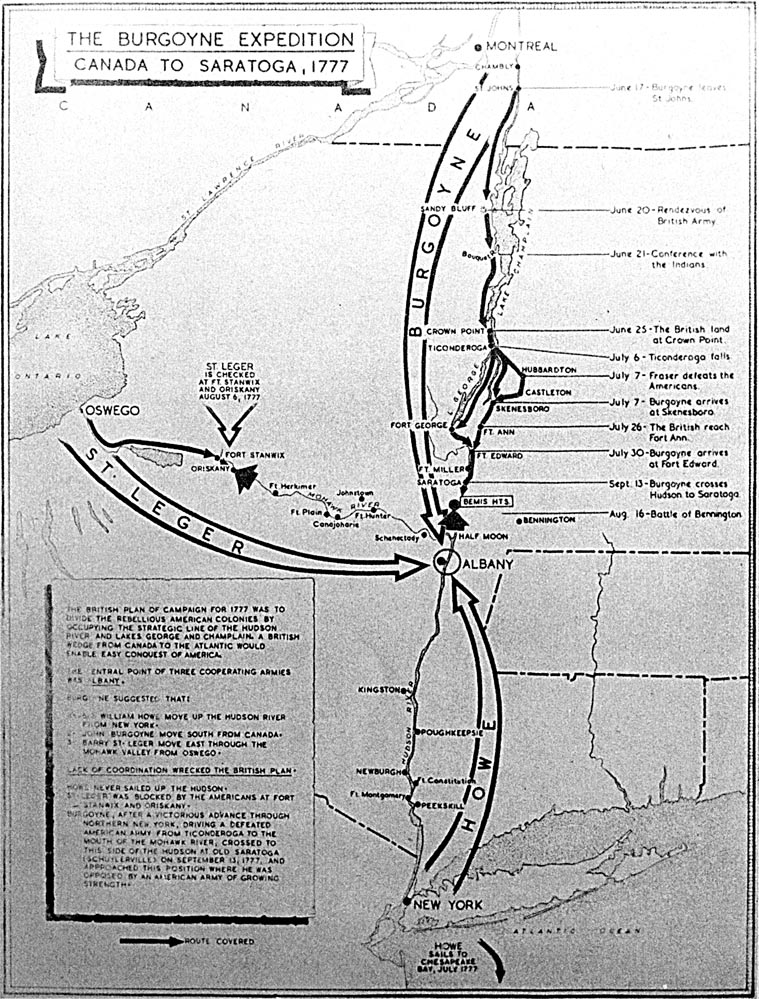
THE BURGOYNE EXPEDITION
CANADA TO SARATOGA, 1777
- June 17—Burgoyne leaves St. Johns
- June 20—Rendezvous of British Army
- June 21—Conference with the Indians
- June 25—The British land at Crown Point
- July 6—Ticonderoga falls
- July 7—Fraser defeats the Americans
- July 7—Burgoyne arrives at Skenesboro
- July 26—The British reach Fort Ann
- July 30—Burgoyne arrives at Fort Edward
- Sept. 13—Burgoyne crosses Hudson to Saratoga
- Aug. 16—Battle of Bennington
THE BRITISH PLAN FOR CAMPAIGN OF 1777 WAS TO DIVIDE THE REBELLIOUS AMERICAN COLONIES BY OCCUPYING THE STRATEGIC LINE OF THE HUDSON RIVER AND LAKES GEORGE AND CHAMPLAIN. A BRITISH WEDGE FROM CANADA TO THE ATLANTIC WOULD ENABLE EASY CONQUEST OF AMERICA.
THE CENTRAL POINT OF THREE COOPERATING ARMIES WAS ALBANY.
BURGOYNE SUGGESTED THAT:
- 1. SIR WILLIAM HOWE MOVE UP THE HUDSON RIVER FROM NEW YORK.
- 2. JOHN BURGOYNE MOVE SOUTH FROM CANADA.
- 3. BARRY ST. LEGER MOVE EAST THROUGH THE MOHAWK VALLEY FROM OSWEGO.
LACK OF COORDINATION WRECKED THE BRITISH PLAN.
HOWE NEVER SAILED UP THE HUDSON.
ST. LEGER WAS BLOCKED BY THE AMERICANS AT FORT STANWIX AND ORISKANY.
BURGOYNE, AFTER A VICTORIOUS ADVANCE THROUGH NORTHERN NEW YORK, DRIVING A DEFEATED AMERICAN ARMY FROM TICONDEROGA TO THE MOUTH OF THE MOHAWK RIVER, CROSSED TO THIS SIDE OF THE HUDSON AT OLD SARATOGA (SCHUYLERVILLE) ON SEPTEMBER 13, 1777, AND APPROACHED THIS POSITION WHERE HE WAS OPPOSED BY AN AMERICAN ARMY OF GROWING STRENGTH.
A contemporary of the event said of it, “Rebellion which a twelve-month ago was a contemptible pygmy, is now in appearance a giant.” Saratoga truly must be considered as one of the cornerstones of American liberty and as one of those momentous events which shape the destiny of nations. Even in the light of the nearly two centuries that have elapsed, the significance of this epochal victory is difficult to appraise fully.
The Hudson River-Lake Champlain route for centuries has constituted a great strategic highway of the continent. Long the warpath of the powerful Iroquois, this route in pre-Revolutionary years had witnessed the ebb and flow of the tides of invasion as England and France locked in a titanic struggle for possession of the New World. Along this route the British commander, General Abercrombie, advanced in 1758 on his ill-fated attempt to seize Ticonderoga from the French. The graves of the “Black Watch” attest the blunders of his judgment. One year later his successor, Lord Amherst, followed the same route, to succeed where his predecessor had failed.
With the outbreak of the Revolutionary War the area again became the scene of active fighting, as colonial arms pushed boldly northward to seize Ticonderoga, Crown Point, and Montreal, and to storm the ramparts of Quebec. In 1776, the British launched a counterattack which, after wiping out most of the American gains, was dramatically checked by the gallant action of the American fleet under Gen. Benedict Arnold on Lake Champlain.
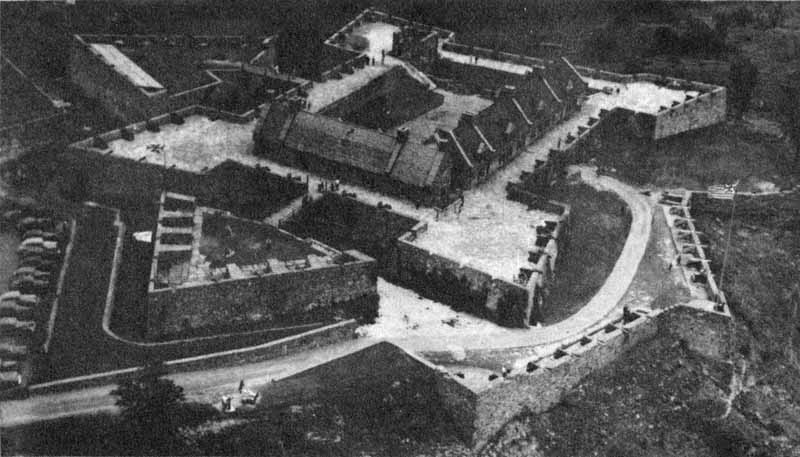
Fort Ticonderoga, the first objective of Burgoyne in 1777. Courtesy Fort Ticonderoga Museum.
It was no idle chance that Britain, after 2 years of futile effort to coerce the colonies, should choose the Hudson-Champlain Valley as the route offering the greatest strategic possibilities for a quick suppression of the rebellion. Obviously, from a military standpoint, once control could be obtained of the ports and the narrow strip of coastal plain along the Atlantic seaboard, the backbone of the rebellion would be broken. By virtue of her seapower, England already had possession of the chief ports. Thus she was able to turn her attention to the second phase of her strategy. Of the 3 million American colonists, approximately three-fourths lived in the narrow border strip from Massachusetts to the northern boundary of Virginia. The key to this populous area was the Hudson-Champlain line. The dominance of this natural avenue of transportation would not only provide an effective barrier separating the New England States from the rest of the struggling colonists, but would remove any menace to the rear of the British armies operating offensively to the south. In control of this area Britain could then crush the separate armies in detail.
The British plan was conceived by Gen. John Burgoyne and approved by the King and Cabinet. It called for a double advance along the Hudson in which the army of Burgoyne moving southward from Canada would effect a junction at Albany with the army of Sir William Howe moving northward from New York City, the two to be joined by Gen. Barry St. Leger moving eastward along the Mohawk from Oswego on Lake Ontario. That this strategy would succeed appeared certain, for against an American army composed chiefly of raw recruits—ill-disciplined and poorly equipped—were matched the seasoned veterans of the British forces, led by the foremost military commanders of the time.
With all the pomp and pageantry characteristic of the 18th century, Burgoyne embarked from St. Johns, Canada, on June 17, 1777, with a force of approximately 9,400 men. He was directed “to proceed with all expedition to Albany and put himself under the command of Sir William Howe.” The army consisted of about 4,700 British regulars, 4,200 German troops hired by the King of England, and between 600 and 700 Canadians, Tories, and Indians. It was accompanied by a splendid train of artillery made up of 138 bronze cannon. Seldom, if ever, has the American continent witnessed a more picturesque display of military splendor. To the gay, multicolored uniforms of the various British, German, Canadian, and Tory regiments were added the bright war paint and feathers of their Indian allies.

Lt. Gen. John Burgoyne, Commander of the British Army which surrendered at Saratoga. Courtesy U. S. Army Signal Corps.
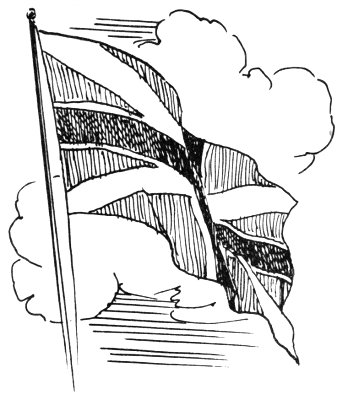
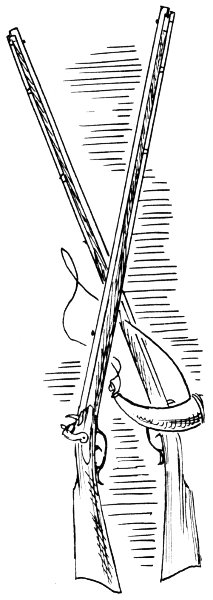

Maj. Gen. Philip Schuyler, first commander of the American troops opposing Burgoyne.
With 3 large vessels, 20 gunboats, and 200 flat-bottomed transports, Burgoyne sailed boldly along the 200-mile length of Lake Champlain to attack his first objective, Fort Ticonderoga, the American guardian of northern New York and New England. On July 1, the British Army reached Fort Ticonderoga and began the siege of this fortress, which was considered by British and Americans alike to be the strongest in North America. A number of factors, unknown to the British and most Americans, however, had caused the strength of Ticonderoga to be greatly overestimated. The lines of the fort had been laid out to be held by an army of at least 10,000 men; the American commander, Gen. Arthur St. Clair had only some 3,000 men on hand with which to defend these vast works. Due to the shortage of men, and perhaps also to neglect, the Americans had failed to fortify steep Sugar Hill (Mount Defiance) which dominated the fort from the southwest. It was the belief of the American leader that the slopes of this mountain were so steep that they would prevent the British from dragging cannon to its top. Burgoyne’s engineers soon dispelled this American illusion, for on the afternoon of July 5 the Americans were horrified to see the Royal Army constructing batteries on the mountaintop. Once these cannon were in position, the American Army was in immediate danger of being completely encircled.
General St. Clair at once made plans to abandon the fortress. That night, under cover of darkness, the American Army began retreating across the bridge of boats which ran from the fort to the east shore of Lake Champlain. Here the American Army split—half of it retreated by land and the other half, with the sick, wounded, and supplies, embarked on the small American fleet and sailed down South Bay to Skenesboro (Whitehall). As the secret retreat was being successfully carried out, one of the buildings in the fort caught fire, and the flames revealed to the British on the summit of Mount Defiance the events that were taking place below.
Burgoyne ordered an instant pursuit. With great speed and energy, the British general, accompanied by the English fleet and part of his army, smashed through the floating bridge, which the Americans had hoped would retard the British pursuit, and sailed swiftly down South Bay after the retreating American fleet. At the same time Burgoyne dispatched Gen. Simon Fraser, with the remaining part of the Royal Army, in pursuit of the American forces retreating by land. On the afternoon of July 6, Burgoyne, with his fleet, overtook the Americans as they neared Skenesboro and proceeded to capture and destroy all that remained of the American fleet, taking many prisoners and supplies, while the remnants of the American Army fled into the forest.
Early on the morning of July 7, General Fraser launched an attack, near Hubbardton, Vt., on the rear guard of the section of the American Army that was retreating by land. After a fierce battle the American force was totally routed and dispersed over the mountains. Near Fort Ann, on July 8, the British also defeated a third force of American troops. Everywhere, then, the American armies were in full retreat before the advance of Burgoyne’s triumphant army. Also there now swarmed ahead of the Royal Army great numbers of savage Indian warriors, terrorizing the settlers of the Hudson Valley.

Maj. Gen. Arthur St. Clair, American commander at Fort Ticonderoga. Courtesy U. S. Army Signal Corps.
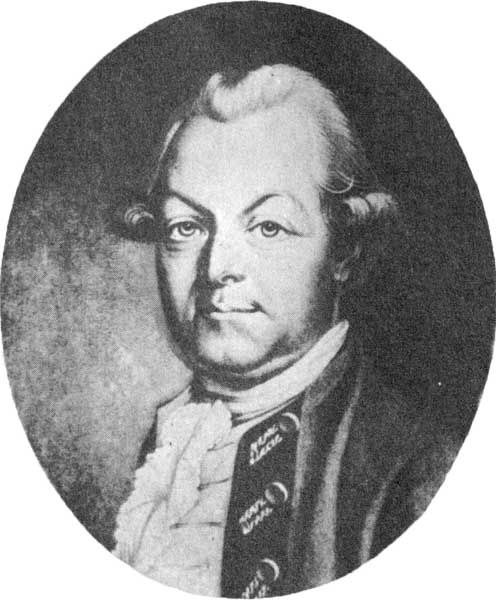
Brig. Gen. Simon Fraser, commander of Burgoyne’s advance corps. Courtesy U.S. Army Signal Corps.
By taking Fort Ticonderoga, Burgoyne had opened the gateway to the Hudson, destroyed the American fleet on Lake Champlain, captured great quantities of supplies, and taken many prisoners as well as 128 American cannon; all at a loss of less than 200 men. George III was so 8 exultant over the news from Ticonderoga that he is said to have exclaimed: “I have beat them! I have beat all the Americans!” The fall of this fortress proved a severe shock to the American morale and served further to increase British contempt for the character of colonial resistance.
Although the roads far to the south were jammed with long lines of wagons, horses, and men of the retreating American Army and with the families of frightened settlers as they fled before the invading army, Gen. Philip Schuyler, the American commander of the Northern Department, had not yet given up the struggle. He concentrated the remnants of the fleeing American forces at Fort Edward, and from there he dispatched hundreds of axmen to fell trees, blocking the roads to the north. Bridges were destroyed, crops burned, and cattle and horses driven off along the route of the British advance. Marching 23 miles overland from Skenesboro through Fort Ann to Fort Edward on the Hudson, Burgoyne encountered innumerable delays because of the rough nature of the country and the effective retarding tactics adopted by General Schuyler. It was not until July 30 that the Royal Army was finally able to reach Fort Edward, 23 days after the battle of Hubbardton. This was an average advance of only 1 mile a day.
On his arrival at Fort Edward the British commander found himself confronted with a new problem. His Indian allies had driven off friend and foe alike, and, in territory where Burgoyne had expected to receive aid and support, he found only abandoned homes and fields. With an army of some 8,500 men, 39 remaining bronze cannon, 1,700 baggage and artillery horses, and 200 head of oxen to supply, and faced with a countryside devastated by his Indians and his foe, the British commander found it necessary to bring practically all of his provisions from Canada. This operation required the utmost efforts of his army, and it was mid-September before Burgoyne could bring forward sufficient supplies to enable him to cross the Hudson at Saratoga.
By this time the tide of events already had started running against the British. This was first evidenced by the news of St. Leger’s defeat at the bloody battle of Oriskany on August 6. St. Leger’s force of about 1,600 men was made up chiefly of Tories, under the leadership of Sir John Johnston and Col. John Butler, and a number of Indians of the Iroquois Confederacy. The Iroquois were divided in their sympathies, but Joseph Brant and his Mohawk warriors and many Cayugas and Senecas joined St. Leger. The immediate objective of St. Leger was to reduce Fort Stanwix, which was held by 500 men under Col. Peter Gansevoort. As the British leader approached the fort, German settlers of the Mohawk Valley assembled under the leadership of Gen. Nicholas Herkimer and 9 advanced to its relief. The Tories and Indians prepared an ambuscade in a ravine near Oriskany, 6 miles below Fort Stanwix, where Herkimer and his farmer militia were almost entirely surrounded. In a desperate struggle with knife, hatchet, bayonet, and clubbed rifle, Herkimer and his men finally put the Indians and Tories to flight from a field that has few, if any, equals in savage horror on the American continent. Herkimer, himself, died from the effects of a wound received on the field of carnage, and his followers were so reduced and exhausted by the ordeal that they were compelled to return to their homes. Sixteen days later St. Leger’s force was dispersed by the defection and desertion of his Indian allies on receipt of news in his camp that a large force under Benedict Arnold, dispatched by General Schuyler, was approaching for the relief of Fort Stanwix. Only a few of St. Leger’s troops ever found their way back to Montreal.

Maj. Gen. Riedesel, commander of the German troops in Burgoyne’s army. Courtesy Fort Ticonderoga Museum.
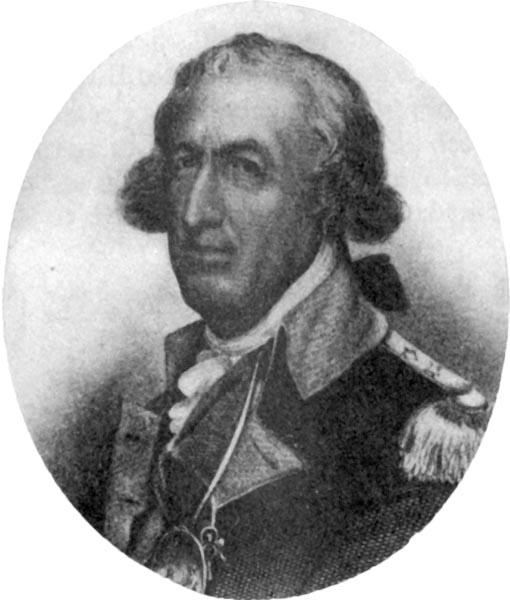
Maj. Gen. Horatio Gates, commander of the American forces at Saratoga. Courtesy Fort Ticonderoga Museum.
Another crushing calamity was in store for the British. Schuyler’s policy of destroying all the crops along the line of Burgoyne’s march had important consequences. It was well known that most of the inhabitants of upper New York, along the Champlain-Hudson route, were favorable to the British cause. Burgoyne had counted on these Tories to aid him materially, especially in the matter of supplies. Now, with the maturing crops systematically destroyed before him, he was faced with difficulty in providing for his army. This led him to send an expedition of about 800 men, under Col. Friedrich Baum, to Bennington, Vt., to capture a large store of supplies which had been gathered there for the American forces. Gen. John Stark aroused the countryside, and the Vermont farmers turned out and on August 16 administered a crushing defeat to Baum’s troops. Another contingent, under Lt. Col. Heinrich Breymann, came up at this time and threatened to undo Stark’s victory, but the timely arrival of Col. Seth Warner and his Green Mountain Rangers overwhelmed Breymann, and the German commander was forced to retreat. By this blow Burgoyne lost approximately 800 men, mostly Germans, and 4 bronze cannon, which seriously weakened his army at a critical time and prevented him from obtaining much needed supplies. The electrifying news of this American victory, after a long series of defeats, not only discouraged Burgoyne’s Indian allies, but also greatly encouraged militia enlistments in the Patriot army.
Of still greater concern to Burgoyne, however, was the fact that no word had been received from Howe concerning his cooperation from the south. As a matter of fact, Howe had chosen to move southward and attack Philadelphia, even though he knew Burgoyne expected to receive his cooperation. Despite these setbacks to the British, which had greatly boosted American morale, Burgoyne, in compliance with his orders, gambling on the belated cooperation of Howe and on his own ability to smash the American force in his front, crossed the Hudson River at Saratoga on September 13. Thus he severed his communications with Canada and risked all on a push to Albany.

The monument on Bemis Heights to Thaddeus Kosciuszko, Polish military engineer who selected and fortified the American lines at Saratoga.
The two recent American victories greatly stimulated the hopes and efforts of the colonists. Men and supplies began to pour into Schuyler’s tiny army which had now retreated as far south as Halfmoon. On August 19, just 3 days after the victory at Bennington, Maj. Gen. Horatio Gates replaced General Schuyler as the commander of the Northern Department. As the American Army increased in confidence and strength, growing from a low point of some 3,000 men, it began advancing slowly up the Hudson. Four miles from Stillwater, the British advance came upon the Americans, 9,000 strong, firmly entrenched at Bemis Heights under the command of Gates.
The American position was well chosen, for here the bluffs so converged with the river as to produce a narrow opening along the river plain through which a passage could be made only at great hazard. With a deep entrenchment blocking the river road, Thaddeus Kosciuszko, the Polish engineer and general who had volunteered in the American cause, had lost no time in establishing a strong line of defense which in appearance was like the segment of a great circle. Powerful batteries extended along the edge of the bluff. From there the line turned northwestward and followed the natural advantages of the ground to a commanding knoll near the site of the Neilson barn where it then turned south by west, terminating at the edge of a ravine approximately three-quarters of a mile distant. The extremities of this position were defended by strong batteries. Most of the line was strengthened by a breastwork, without entrenchments, constructed from the trunks of felled trees, logs, and rails.
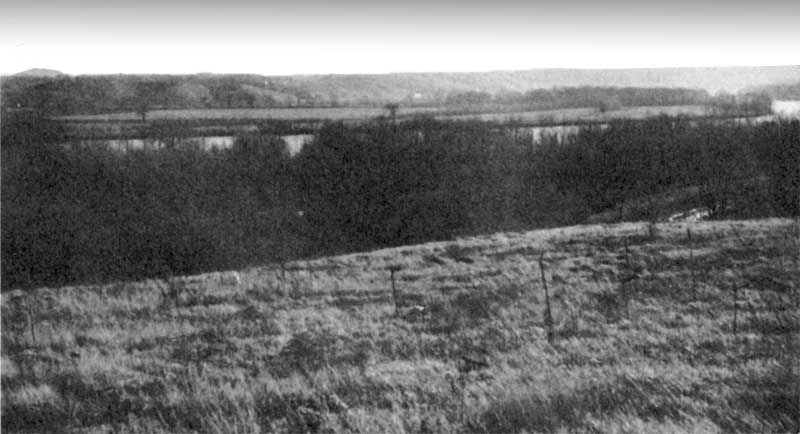
View looking east from the American river batteries, the key to the American defensive position. It commanded the Hudson River and thus blocked Burgoyne’s advance.
At the apex of the line, Neilson’s barn was converted into a rude fort, and a strong battery was established at this point. Running in front of the right wing of the American position, in a parallel direction, was a 12 deep, heavily wooded ravine. The area immediately in front and to the west of the center of the American line, however, had been partially cleared, so that the felled trees made an abatis difficult to penetrate. Except for a small number of scattered farm clearings, the rough and rolling ground to the north of the American position was so thickly wooded as to furnish a distinct handicap to a coordinated attack or to the proper use of artillery.
Behind the right wing of the American position were stationed the Continental brigades of Nixon, Paterson, and Glover under the immediate command of Gates. Behind the center and left were the Continental brigades of Poor and Learned; also the 500 Virginia riflemen and 300 Light Infantry of Major Dearborn, which together composed a corps led by Col. Daniel Morgan. Morgan’s riflemen had been specially assigned by General Washington to the force confronting Burgoyne, as they were well versed in backwoods fighting and were calculated to offset the Indian and Tory allies of the British. The troops led by Poor, Learned, and Morgan constituted a division under the command of Arnold. Present with the American Army was an artillery train of 22 cannon. Thus stationed, and continuing to improve their fortifications, the American troops awaited the advance of Burgoyne.
It was at this point in the campaign that Burgoyne felt most severely the loss of his Indian allies. After his attempt to discipline the Indians for their brutal murder of Jane McCrea at Fort Edward on July 27, and the two British reverses at Oriskany and Bennington, the Indian nations rapidly began to abandon the royal cause. Up to this time the front and flanks of Burgoyne’s army had been covered with an almost impenetrable cloak of savage warriors who had closely harassed the retreating American Army, attacking small detachments and bringing Burgoyne valuable information on American movements. With the loss of his Indian warriors, however, the situation was reversed. Burgoyne was deprived of military intelligence; and, hovering about the Royal Army were hundreds of American scouts who attacked small British units and counted in detail the numbers of men, tents, wagons, and boats in Burgoyne’s army.
Thus, on September 19, Burgoyne had little accurate information on the strength or disposition of the American Army that blocked his way to Albany. A heavy fog covered both the American and British camps 13 that morning. While the Royal Army waited for the heavy mists to lift, they prepared to advance in three parallel columns, as they had previously done since crossing the river at Saratoga. Burgoyne’s objective that day was to move his army safely forward through the heavy forests to a position near enough to the hidden American camp to enable him to begin effective operations against the American lines.

THE FIRST BATTLE OF FREEMAN’S FARM (SARATOGA)
SEPTEMBER 19, 1777.
RECONNAISSANCE CONVINCED BURGOYNE THAT IN ORDER TO REACH ALBANY HE HAD TO ATTACK THE AMERICAN ARMY WHICH BLOCKED HIS WAY AT BEMIS HEIGHTS.
ON SEPTEMBER 19, 1777 BURGOYNE MOVED FROM HIS CAMP NEAR THE SWORD HOUSE IN THREE DIVISIONS. RIEDESEL MOVED FORWARD ON THE RIVER ROAD. BURGOYNE COMMANDED THE CENTER. FRASER MOVED THROUGH THE WOODS ON THE RIGHT. AT MIDDAY BURGOYNE’S TROOPS ACCIDENTALLY ENCOUNTERED SOME OF MORGAN’S MEN NEAR FREEMAN’S FARM, ABOUT ONE MILE NORTH OF THIS POINT.
A SAVAGE BATTLE ENSUED. REINFORCEMENTS WERE THROWN IN BY BOTH SIDES. THE FREEMAN FARM CLEARING WAS REPEATEDLY WON AND LOST BY THE OPPOSING FORCES UNTIL NIGHTFALL. RIEDESEL’S TIMELY ARRIVAL FROM THE RIVER SAVED BURGOYNE FROM TOTAL DEFEAT. THE AMERICANS WITHDREW INTO THEIR CAMP, WHERE YOU NOW STAND, LEAVING BURGOYNE MASTER OF THE FIELD.

Col. Daniel Morgan.
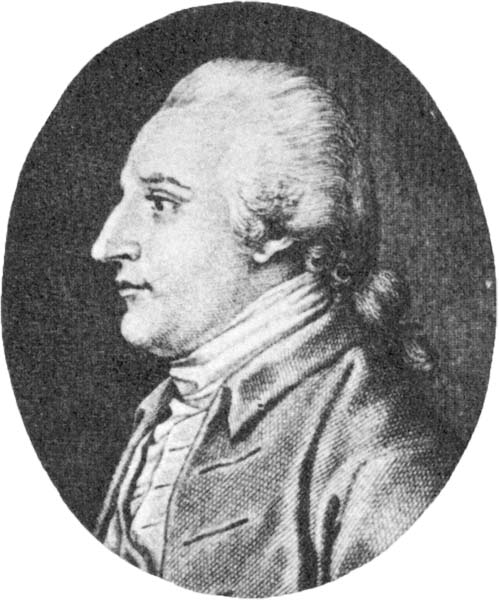
Brig. Gen. Benedict Arnold. Courtesy Fort Ticonderoga Museum.
Accordingly, on the morning of September 19, Burgoyne moved forward in three columns from his encampment in the vicinity of the Sword House. The right column under Fraser, numbering 2,830 men composed of British and German grenadiers and light infantry, together with the British 24th regiment and the irregulars, advanced along the road running westward from the Sword House to a point 3 miles distant where it then turned south. The center column, consisting of the British 9th, 20th, 21st, and 62nd regiments, was led by Burgoyne. This force, which numbered approximately 1,840 men, followed the route of Fraser for a short distance and then turned southeast at the first fork which led to the Great Ravine. Crossing the ravine, the column then turned westward in an effort to take a position parallel in line with Fraser’s column. The left column of about 3,160 men under General Riedesel, consisting of six companies of the British 47th regiment and the German regiments of Riedesel, Rhetz, Specht, and Hesse Hanau, was to advance along the 15 river road accompanied by the heavy artillery, the baggage train, and bateaux. They were to await the signal gun which would indicate that the right and center columns under Fraser and Burgoyne had reached the proper positions. Then, all three columns were to begin advancing toward the American camp until a strong position could be found close enough to it to serve as a base for further operations.
American scouts from the east side of the Hudson detected the forward movement of Riedesel’s column along the river road. When Gates was first advised by his scouts of the British advance, he determined to await their attack behind his breastwork. Arnold, however, insisted that the issue should be fought in the field. He reasoned that the forest would not only handicap the British from the standpoint of coordinated attack and the full use of their artillery, but it would also offer a screen peculiarly adaptable to the American style of fighting. If defeated in the field, he argued, the troops could then fall back to their entrenchments.
Finally yielding to Arnold’s wish, Gates ordered out Morgan’s riflemen, supported by Dearborn’s light infantry, to reconnoiter the position of the enemy. Moving northward along the road from Fort Neilson, Morgan divided his forces in an effort to locate the enemy. The first phase of the engagement opened about 12:30 in the afternoon when a detachment of Morgan’s men brushed with the advance guard of Burgoyne’s center column in a clearing known as Freeman’s Farm. The first volley all but wiped out the British picket. Rushing forward in hot pursuit of the few survivors, the detachment ran head-on into the main body of Burgoyne’s center column only to be driven back in turn and widely scattered. By persistent use of his turkey call signal, however, Morgan was able to rally his men and prepare for the second phase of the engagement. Aided by the arrival of the regiments of Colonels Cilley and Scammel from Poor’s brigade, he re-formed his line in the woods along the southern edge of the 15-acre clearing.
Forming his line along the northern edge of the Freeman clearing, Burgoyne advanced to the attack with the 21st regiment on the right, the 62nd in the center, and the 20th on the left. Morgan’s men suddenly poured such a withering fire into the solidly advancing columns that the British line wavered and fell back across the clearing. Following closely, the Americans were again driven back, as the British quickly rallied their lines.
For more than 3 hours the fighting swayed back and forth across the bitterly contested clearing as each side strove desperately for a decision. Repeatedly the hard-pressed British regiments charged with the bayonet, only to be stopped short by the deadly fire of the American riflemen. Under the skillful direction of Arnold, American reinforcements were so placed as to threaten seriously to outflank the British right. Finally, when the British position had become critical, Riedesel arrived with fresh reinforcements. Throwing his men with great force against the American right, he succeeded in steadying the British line and forcing the Americans to withdraw gradually. But for the arrival of Riedesel, the fate of the Burgoyne campaign might well have been decided here. Approximately 4,000 Americans participated in this fight, while about 5,000 more were held inactive by Gates behind the fortified lines. The attacking American force was opposed through most of the day by the 1,800 British soldiers that composed Burgoyne’s center column. It was almost dusk before Fraser’s 2,800 men and the 550 German troops under General Riedesel came to Burgoyne’s aid.
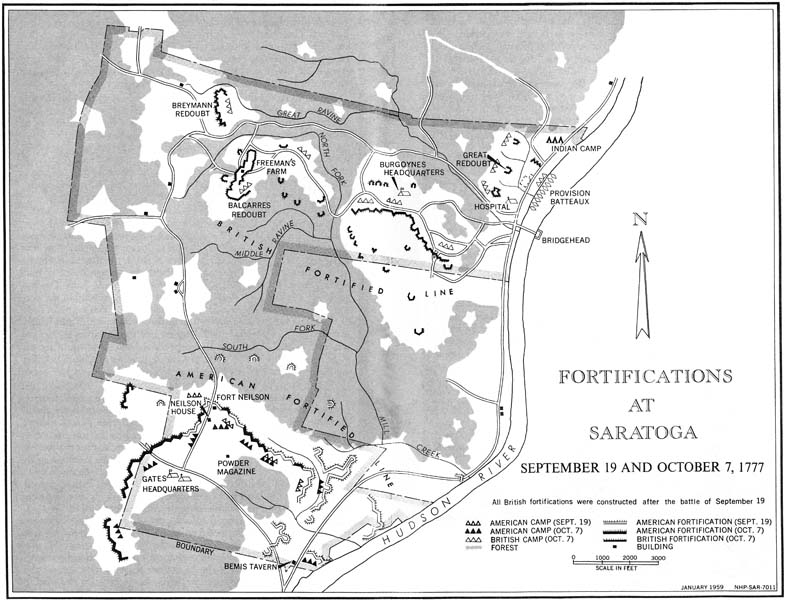
FORTIFICATIONS AT SARATOGA
SEPTEMBER 19 AND OCTOBER 7, 1777
All British fortifications were constructed after the battle of September 19
The first battle was thus fought under the “fog of war.” Because of the great forest which shielded each army from the other, neither Burgoyne nor Gates was sure of the other’s dispositions or intentions. General Burgoyne believed that the main American attack was directed against his right and thus held Fraser with the elite troops in reserve. General Gates, on the other hand, was of the opinion that the main British attack was directed against the American right along the river road and therefore held back the 5,000 American troops to defend this key pass. For this reason, the battling columns were reinforced only in a piecemeal fashion by both generals until late in the day. The contestants were thus evenly matched until dusk when Burgoyne finally ordered in regiments from both flanking columns and drove the Americans from the field of battle. The heavy, unknown forest and darkness, however, prevented any effective pursuit.
Stopped in his advance about 1 mile north of the American lines with a badly crippled army, but left in possession of the immediate field of battle, Burgoyne decided to entrench his troops in the vicinity of the Freeman Farm. There he awaited the cooperation of Howe or Sir Henry Clinton, who was then stationed in New York. He also felt the need of reconnoitering the American position as he still knew virtually nothing about it.

View northeast from the American river batteries, showing how American cannon dominated the narrow river plain and road at this point.
Confident and self-assured as a result of their first encounter, the American troops grew restive as they impatiently awaited a further attack. Despite drenching rains, chill nights, inadequate supplies, and scanty rations, these ragged troops, who held the destiny of a nation in their hands, could still find heart to make merry at night. So exuberant was their revelry, in fact, that the sentries complained that because of the noise they could not hear the British and would find it impossible to warn their comrades if they did. In order to correct this condition, Gates had to issue an early curfew order.

THE SECOND BATTLE
FREEMAN’S FARM
(SARATOGA) OCTOBER 7, 1777
Nearly 3 weeks of futile waiting brought Burgoyne no aid from either Howe or Clinton. On October 6, however, unknown to Burgoyne, Clinton did succeed in capturing the forts along the highlands of the Hudson (he reached as far north as Esopus [Kingston] on October 16). With the strength of his opponent greatly increased by the arrival of 4,000 militia reinforcements so that he was outnumbered now two to one, and, with his supplies rapidly diminishing, Burgoyne’s position became a desperate one, necessitating either an advance or a retreat. After some hesitation, he decided to risk everything on a second battle.

Uniform of an American officer, regiment unknown: black hat, brown coat, red facings, red and white waistcoat, red epaulette, buff breeches, white stockings.

Uniform of an American soldier, regiment unknown: black hat with brown brush, gray coat with yellow facings, red-brown breeches, and light blue stockings.
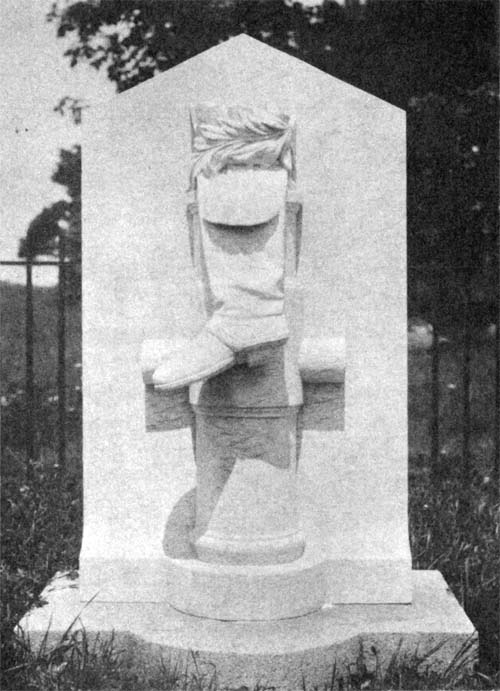
Unique monument to Arnold’s left leg which was wounded in the storming of the Breymann Redoubt in the battle of October 7.
Accordingly, on the morning of October 7, Burgoyne ordered a reconnaissance in force to determine the nature of the ground and the advisability of a thrust at the American left. With 1,500 picked men, led by Generals Fraser, Riedesel, and Phillips, and supported by two 12-pounders, six 6-pounders, and two howitzers, Burgoyne moved out from camp about 12 o’clock and advanced toward the American left. After moving in a southwesterly direction for a distance of approximately two-thirds of a mile, the troops deployed in an open clearing where some of them foraged in a wheat field.
Extending his line for more than 1,000 yards to the west, Burgoyne occupied the southern slope of the rise of ground just north of the Middle Ravine. On the right, under the Earl of Balcarres, was stationed the British Light Infantry and the British 24th regiment, both under the command of General Fraser. In the center was Riedesel with his German contingent and batteries of two 12-pounders and two 6-pounders under Major Williams and Captain Pausch. On the left was stationed Major Acland in command of the British Grenadiers with the greater portion of the artillery. Though the larger part of Burgoyne’s front was open, both his flanks rested in woods and were thus exposed to a surprise attack. Investigating the news of the British advance, James Wilkinson, Adjutant General to Gates, found their position favorable to 22 attack and so reported to headquarters, whereupon Gates replied: “Order on Morgan to begin the game.”
The American plan of attack was simple and direct. As Morgan undertook a flanking movement against the Light Infantry on the British right in that portion of the field farthest removed from the river, Poor was to move against the Grenadiers on the British left. Once these two movements had developed, Learned was to strike the German contingent which made up the British center. The American attack opened about 2:30 in the afternoon with Poor’s savage assault upon the British left. Outnumbered two to one, the Grenadiers crumpled under the withering fire of the Americans. By this time Morgan had struck the British right. The British Light Infantry was driven back in confusion, and the right flank and rear of the troops led by Balcarres were now seriously threatened.
At this critical stage, General Fraser rode back and forth among his men in a desperate effort to encourage them to make a stand and cover the developing British retreat. In spite of all that he could do, his troops continued to withdraw under the deadly fire of Morgan’s corps. In the confusion of attack and retreat, General Fraser was shot, perhaps by a member of a party detailed for that purpose by Colonel Morgan. Mortally wounded, he was carried from the field.
Before the enemy’s flanks could be rallied, Arnold dashed impetuously onto the field and led Learned’s brigade in an attack against the Germans, who comprised Burgoyne’s center. Although without command because of a quarrel with Gates after the battle of September 19, Arnold now threw himself into the battle. By his powerful personality and reckless daring he inspired the troops to redoubled effort. Though the Germans repulsed the first attack, they were soon driven into retreat, for the withdrawal of Fraser’s troops and the British Grenadiers had exposed them on both flanks.
When the 2,000-strong Albany County militia, commanded by Brig. Gen. Abraham Ten Broeck, came up to join the fighting, the British forces, discouraged by the loss of Fraser and the turn of events, retreated to the protection of their fortified positions. Within less than an hour after the opening of the attack, Burgoyne had lost 8 cannon and more than 400 officers and men, killed, wounded, or prisoners. Flushed with victory, part of the American forces were led by Arnold in a savage and costly attack on the Balcarres Redoubt, a position of great strength which lay on the Freeman Farm.

View of the West Bank of the Hudson’s River 3 Miles above Still Water, upon which the Army under the command of Lt. General Burgoyne, took post on 20th. Sepr 1777 (Shewing General Frazer’s Funeral.)
This print, published in London in 1789, presumably shows the British position at the Great Redoubt. According to the inscription accompanying the original print, it also portrays a scene during Fraser’s funeral. The original inscription seems to contain certain inconsistencies. Courtesy Life Magazine.
When repeated attacks failed to carry this position, into which the remnants of Burgoyne’s flanking column had retreated, Arnold wheeled his horse and, dashing between the crossfire from both armies, rode northward in the direction of the Breymann Redoubt. In front of this work were American units that had circled farther to the north after the retreat of the British flanking column and had taken no part in the attack on the Balcarres Redoubt. Between the Balcarres and Breymann Redoubts stood two log cabins, held by Canadian troops. The attack on Breymann’s position was being delayed until these cabins could be overcome. At about the time that Arnold arrived at the Breymann Redoubt, an attack was launched against the front and left of the fortification. Arnold joined the men attacking the left and rear. The combined attacks rapidly drove the defending German troops from the redoubt. Only darkness saved Burgoyne from a general retreat. As Arnold entered the rear of the redoubt, just as the work fell, he was shot in the leg by a German soldier. Had he died there, posterity would have known few names brighter than that of Benedict Arnold. The fall of this redoubt, which covered the right and rear of Burgoyne’s fortified camp, forced him to order a general retreat. Colonel Breymann was killed in the assault on the redoubt that bears his name.
That night Burgoyne withdrew his army to the high ground north of the Great Ravine. Fraser’s life slowly ebbed away throughout the night, and on the evening of October 8 he was buried in the Great Redoubt, in accordance with his own request. The retreat of the army northward was held up by Burgoyne long enough to administer the last rites in an impressive ceremony as Fraser’s body was lowered into the ground. Shots from American gunners, who did not understand what was taking place, struck close and threw dust on the officiating chaplain. Early in the morning of October 9, the British Army took up its retreat to Saratoga. The British had suffered approximately 1,000 casualties in the fighting of the past 3 weeks as compared to an American loss of less than half that number.
An American force was already present on the east side of the Hudson, opposite Saratoga, thus blocking the crossing of the river. To continue the retreat northward in an effort to reach Fort Edward was now almost impossible for Burgoyne’s weary and badly depleted army. In a few days he was completely surrounded on the heights of Saratoga by the American force which, by this time, had grown to about 20,000 men. Hopelessly outnumbered, provisions all but exhausted, and devoid of hope of help from the south, Burgoyne was forced to surrender on October 17, 1777.

62nd British Regiment uniform: red coat (cut down), short black canvas gaiters, buff facings, waistcoat and breeches, white regimental lace with two blue and one yellow or straw-colored stripes. From an early print.
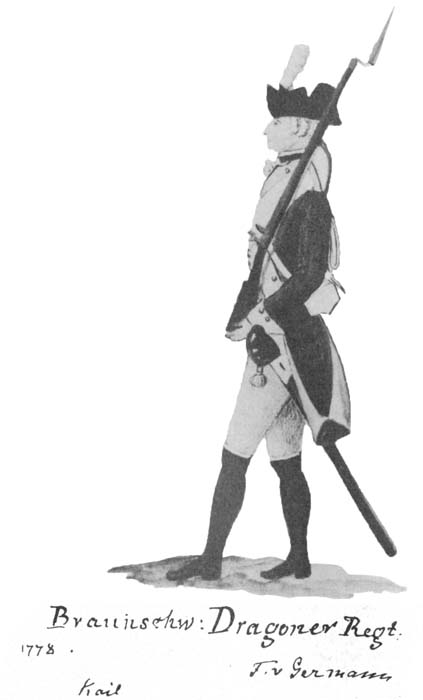
Brunswick Dragoon Regiment uniform: light blue coat with yellow facings and waistcoat, leather breeches. From an early print.
The remnants of Burgoyne’s army, probably numbering about 5,800 men, stacked their arms on the level flood plains along the banks of the Hudson near the ruins of Old Fort Hardy and became prisoners of war, according to the terms of the Convention of Saratoga drawn up between Gates and Burgoyne. By the terms of surrender, they were to be taken to Boston where they would board vessels to return to England. It was provided that they would not serve again in North America during the Revolutionary War. Burgoyne, by inducing Gates to sign this convention, almost succeeded in nullifying the great American victory at Saratoga. If the terms of the convention had been carried out, Burgoyne’s army would have been available for service in Europe against the French, whom the Americans were at this time desperately endeavoring to induce to enter the war on the American side; or Burgoyne’s army could have been used to relieve for service in America an equal number of British troops then garrisoning posts in other parts of the Empire, thus largely repairing, within 6 months’ time, the damage to the British armies in North America. The Continental Congress therefore interposed first one obstacle and then another, and the terms of the convention were never kept. The captured soldiers were held in the North for about a year, and then most of them were sent to Charlottesville, Va., for the duration of the war. The majority of these prisoners remained in this country after the close of the war and were gradually absorbed among the populace of the new nation. Many American families today can trace their origin back to the British and German soldiers who surrendered at Saratoga.
The failure of the Burgoyne expedition, so auspiciously launched, may be attributed to a series of blunders and misfortunes climaxed by the heroic defense of a despised adversary. In his failure specifically to order Howe to cooperate with Burgoyne, the British Colonial Secretary, Lord George Germain, in the very beginning laid the basis for the campaign’s fatal ending. Through carelessness, this order, though prepared, was apparently never mailed and was allowed to remain tucked away in a pigeonhole. To this costly blunder was added the refusal of Howe to cooperate in the northern expedition, despite the fact that he had been informed by Burgoyne and others of the expected nature of his participation. When advised by Howe of his proposed expedition against Philadelphia, Germain approved the plan but expressed the hope that it would be completed in time for cooperation with Burgoyne.
In persisting in the Philadelphia expedition against the advice of Clinton and other British officers who advised cooperation with Burgoyne, Howe preferred a plan of campaign which gained the British nothing to a plan which might well have won them the war. In his defense later, Howe argued that he had received no order to cooperate with the northern army; that he had warned Burgoyne not to expect aid from the south; that his move to Philadelphia had been approved by the King; and finally that he had advised Clinton to assist Burgoyne. This move of Clinton’s however, came so late, and with such limited force, as to make it ineffective.

This old print, after the famous painting by John Graham, portrays the burial of General Fraser. The English historian, Fonblanque, has identified the portrait figures from left to right as: Earl of Harrington, A.D.C.; General Burgoyne; Major-General Phillips; Reverend Brudenell; Captain Green, A.D.C.; Lieutenant Colonel Kingston; Major Fraser; Mr. Wood, Surgeon; Earl of Balcarres; Major General Riedesel. Courtesy Life Magazine.
As if this were not enough, Burgoyne’s position was still further weakened by the inability of St. Leger to create a proper diversion along the Mohawk. These blunders and misfortunes, inherently grave as they were, do not absolve Burgoyne altogether from responsibility for the failure of the northern campaign. His conduct of the campaign, at times, lacked forceful initiative and drive, to which were added grave errors of judgment, the most serious of which, in all probability, was the poorly planned expedition against Bennington. The imperative orders given to Burgoyne by British ministers in England, with little leeway to adjust his plans according to the actual course of events, was another important cause of the complete failure of the campaign. Sir Guy Carleton, then Governor of Canada, wrote in 1777: “This unfortunate event, it is to be hoped, will in the future prevent ministers from pretending to direct operations of war, in a country at three thousand miles distance, of which they have so little knowledge as not to be able to distinguish between good, bad, or interested advices, or to give positive orders in matters, which from their nature, are ever upon the change; so that expedience or propriety of a measure at one moment, may be totally inexpedient or improper in the next.”

Three examples of the so-called Kentucky Rifle, the type of weapon carried by most of Morgan’s Corps of riflemen. These rifled guns were much more accurate than the smooth-bore muskets used by most of the soldiers on both sides during the American Revolution.
In no small sense, however, the success of the American cause may be attributed to the skill of the colonial infantry who, under the daring leadership of Arnold and Morgan, had proved themselves more than a match for the British veterans. Furthermore, the American ability to increase their numbers within a short period of time materially added to their ultimate success. The speed with which the county and State governments called up the militia levies and forwarded the needed supplies enhanced the American position; so that as Burgoyne’s manpower and supply situation became increasingly desperate, Gates’ became stronger. Although most of the fighting at Saratoga was done by Continental troops, corresponding to what we would call regulars the presence of the militia made possible the commitment to the battles of the better trained and organized Continentals.

This famous painting of the surrender of General Burgoyne at Saratoga, by John Trumbull, is of a memorial nature. It does not attempt to reconstruct the actual scene. The four figures in the central foreground are Generals Phillips, Burgoyne, and Gates, and Colonel Morgan. Courtesy Yale University Art Gallery.

Burgoyne cannon. This 24-pounder bronze gun was one of the pieces of artillery surrendered by the British at Saratoga.
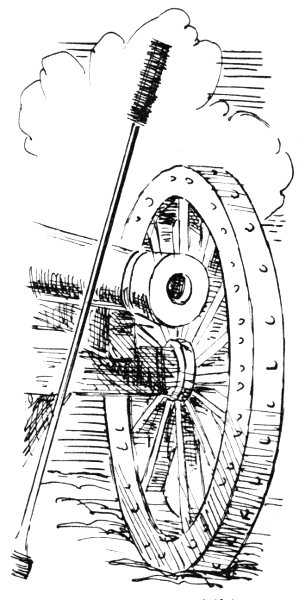
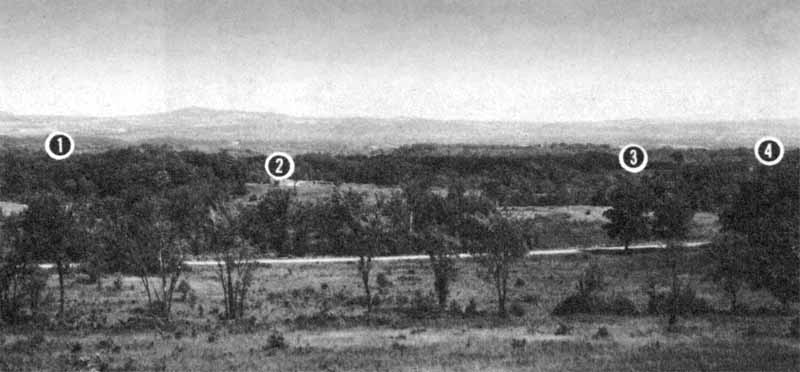
View east from Fraser’s Hill with the Hudson Valley Hills and Green Mountains in the distance, showing the terrain held by the British line and the ground most bitterly fought over in the battle of October 7. On the bluffs overlooking the river is the site of the Great Redoubt (1) where Fraser was buried and from where the British began their retreat northward to Saratoga (now Schuylerville). The Breymann Redoubt (2) was in the cleared area adjacent to the woods. The Freeman Farm (3), where the battle of September 19 began, was later included within the British lines. The Balcarres Redoubt ran from the Freeman Farm right to (4).
The employment of Indians by the British and the outrages perpetrated by them upon the civilian populace, of which the murder of Jane McCrae was the most noted, helped to give a sense of urgency to the people of the region. This resulted in a greater degree of wholehearted support of the American military effort than might otherwise have been the case.
Saratoga National Historical Park is an area of exceptional scenic beauty, the terrain of the park being characterized by sharply rising bluffs, deep ravines, and rolling hills. Its present open clearings are in sharp contrast to its heavily wooded appearance in 1777.
Though time has left few vestiges of the American and British fortifications, an effort is being made to establish definitely their original character and position by historical and archeological research.
The river bluffs on which American batteries were emplaced dictated the tactics of both armies and the course of the two battles of Saratoga. The American line was anchored on these bluffs, because here the high ground converged with the river to allow only a narrow corridor along the river plain. The road south to Albany ran through this corridor. Both battles were fought as a result of the British attempt to flank the American positions controlling this passageway. This terrain factor must be appreciated if the course of events at Saratoga is to be understood.

View of the Freeman Farm from the east, showing the scene of the heaviest fighting of the Battles of Saratoga.

View looking northeast from the site of Fort Neilson, a key point dominating the left flank and center of the American defensive position.
Situated on the crest of Bemis Heights at the apex of the American line, stood Fort Neilson. In reality the fort was a fortified barn, named for John Neilson, the farmer who owned it. Strengthened on either side by heavy batteries and protected by a breastwork of logs and felled trees, the fort constituted a key point in the American line. The overlook from this point offers a sweeping panorama of exceptional beauty and charm. From here are visible the Adirondacks, the Green Mountains in Vermont, the Berkshires in Massachusetts, and the Catskills.
Now standing on the site of Fort Neilson is the Block House, containing relics of the Revolutionary period and exhibits designed to present the story of the Battles of Saratoga and the Burgoyne Campaign.
Located within the fortified area of Fort Neilson, the Neilson House is the only contemporary building still standing on the battlefield. This house, the home of John Neilson, served as the quarters of Generals Benedict Arnold and Enoch Poor. From this building Poor went to lead his troops in gallant action on both September 19 and October 7. It was to this building that Major Acland, of the British Grenadiers, was brought severely wounded on October 7; and it was also to this building that Lady Acland, in defiance of great hardships, came to nurse her wounded husband. The smoked walls, planked floors, and rough period furniture preserve much of the Revolutionary atmosphere.
On the little plateau east and below the site of Fort Neilson, near the center of the American line, is located a reconstructed stone powder magazine. From the report of Ebenezer Stevens, Major Commandant of Artillery, entitled, “Return of Ordnance and Stores in Camp near Stillwater, September 24, 1777,” with a subheading, “Stores in Magazine,” it has been possible to determine the exact character and quantity of the supplies located within the magazine.
No part of the battlefield witnessed heavier fighting than the area known as Freeman’s Farm. Around this farmhouse and its oblong clearing of 15 acres, the swirling tides of battle beat relentlessly in the engagements of both September 19 and October 7. The original Freeman farmhouse, owned at the time of the battles by Isaac Leggett, occupied approximately the site of the present building by that name. Following the battle of September 19, it was included within the fortification known as the Balcarres Redoubt. The oblong clearing ran east and west across the same small ridge on which the Freeman house stood.

The John Neilson House. This structure, situated on Bemis Heights, is the only contemporary building remaining on the battlefield.
Situated on the same ridge as the Freeman farmhouse, the Balcarres Redoubt extended approximately 500 yards in a north-south direction. The redoubt was an enclosed work mounting eight cannon, with walls from 12 to 14 feet in height and constructed of logs with earth thrown over them. The front of this work was covered with a strong abatis built of felled trees. The Balcarres Redoubt thus constituted the strongest fortification of the British line. Under the command of the Earl of Balcarres, the fortification was erected shortly after the Battle of September 19 and was occupied by the British Light Infantry. In fierce attacks, the American forces, on October 7, repeatedly 34 assailed this redoubt in vain. Arnold’s successful assault on the Breymann Redoubt, however, finally served to outflank the position and force its evacuation.

This shaft was erected in 1931 by the Daughters of the American Revolution of New York State as a memorial to the American soldiers who died at Saratoga.
The Breymann Redoubt was situated on the extreme right flank of the British line and was erected to defend the right flank of the Balcarres Redoubt and to cover a road that ran from this point to the American camp. The Breymann Redoubt thus served as the key to the entire British position. The redoubt was constructed and defended by German troops, under command of Lieutenant Colonel Breymann, shortly after the battle of September 19. It consisted of a single line of breastworks, approximately 200 yards in length, with short flank defenses and no works in the rear. On the right, on high ground, it mounted a battery of two cannon that was captured by the Americans on October 7. The ground before the redoubt was cleared and there was no abatis before this work. The walls of the redoubt were constructed of logs and rails. The logs were laid horizontally one upon the other and were supported between upright pickets, or posts, driven into the ground on either side of the wall and fastened together at the top. The breastwork was between 7 and 8 feet in height, with an opening of about 9 or 10 inches wide, at a suitable height for small arms. It was here in the closing hours of October 7 that Arnold took part in the dramatic assault that sealed the fate of the Burgoyne Campaign. The unique monument to Arnold’s wounded leg is located on the site of the Breymann Redoubt.
Situated approximately three-fourths of a mile northwest of the site of Fort Neilson and extending some 1,000 yards west of present State Route 32, is the position which the flanking column of 1,500 soldiers under Burgoyne occupied at the beginning of the American attack on October 7. Here on the southern slope of the rise of ground, just north of the Middle Ravine, the British met 35 the full fury of the first American attack. It was in this area that General Fraser received his mortal wound and many other British officers were killed, wounded, or taken prisoner before Burgoyne ordered a retreat to the Balcarres Redoubt. The badly wounded Major Acland, commander of the British Grenadiers, and Major Williams, commander of the British Artillery, were both taken prisoners by the Americans in this area on October 7.

The Schuyler House. The main part of this building was erected by Gen. Philip Schuyler to replace an earlier house, which was burned by Burgoyne’s troops on October 10, 1777. The house, situated in Schuylerville (Old Saratoga), is being restored to the period of Schuyler family occupancy.
Situated at Schuylerville (Old Saratoga), N.Y., this estate was the summer residence of Gen. Philip Schuyler both before and after the Battles of Saratoga. The present house was erected in 1777 by General Schuyler shortly after the surrender of Burgoyne’s army. It stands near the site of his former home, which was burned by Burgoyne. Restoration to the period of occupancy by the Schuyler family is under way, with further studies yet to be completed. The structure is a 2-story frame house, 60 feet long by 21 feet wide. The walls are filled in with brick. There are seven spacious rooms on the first floor and, in addition, a large kitchen. On the second floor there are seven bedrooms in the main part of the house and four more over the kitchen. Gen. John Stark, George Washington, Governor Clinton, and Alexander Hamilton were guests of the Schuylers in this house.
The park is on the upper Hudson River, 28 miles north of Albany, N.Y., between the villages of Stillwater and Schuylerville, and may be reached by automobile from the north or south over State Route 32, connecting with U.S. 4 at Bemis Heights and Schuylerville. From the west, convenient connections with U.S. 9 may be made over State Routes 9P and 423. Taxi service is available from Mechanicville, Schuylerville, and Saratoga Springs.
The park and its facilities are open from early spring until late autumn, depending upon weather conditions—normally from April 1 to November 30.
A museum, containing relics of the Revolutionary Period and exhibits designed to present the story of the Battles of Saratoga and the Burgoyne Campaign, is open daily, Sundays and holidays included, from 8:30 a.m. to 5 p.m. Park literature is available in the museum. The John Neilson House, used as quarters for American staff officers during the battles, is also usually open to visitors. Informational signs and markers along the park roads will assist you to visualize events connected with the battles.
Special service, without charge, is provided for school classes, civic groups, and organizations when arrangements are made in advance through the park administration.
In 1938, Congress authorized the establishment of Saratoga National Historical Park. In 1941, under this authority, 1,429 acres of historically important land, previously acquired by the State of New York, were accepted by the Federal Government for administration and protection as a National Historical Park Project. Later, other historically significant parts of the battlefield were acquired, and the establishment of the park was accomplished on June 22, 1948. The present area is almost 4 square miles.
Saratoga National Historical Park is administered by the National Park Service, U.S. Department of the Interior. Communications regarding the park should be addressed to the Superintendent, Saratoga National Historical Park, R.F.D. No. 1, Stillwater, N.Y.
Fuller, J. F. C., Decisive Battles of the U.S.A. Harper Bros., New York, 1942.
Nickerson, Hoffman, The Turning Point of the Revolution. Houghton Mifflin Company, Boston and New York, 1928.
Whitten, F. E., The American War of Independence. Dodd, Mead & Company, New York, 1931.
FOR SALE BY THE SUPERINTENDENT OF DOCUMENTS, U.S. GOVERNMENT PRINTING OFFICE, WASHINGTON 25, D.C.

American combination knapsack and haversack
End of the Project Gutenberg EBook of Saratoga National Historical Park, New
York, by Charles W. Snell and Francis F. Wilshin
*** END OF THIS PROJECT GUTENBERG EBOOK SARATOGA NATIONAL HISTORICAL PARK ***
***** This file should be named 56428-h.htm or 56428-h.zip *****
This and all associated files of various formats will be found in:
http://www.gutenberg.org/5/6/4/2/56428/
Produced by Stephen Hutcheson and the Online Distributed
Proofreading Team at http://www.pgdp.net
Updated editions will replace the previous one--the old editions will
be renamed.
Creating the works from print editions not protected by U.S. copyright
law means that no one owns a United States copyright in these works,
so the Foundation (and you!) can copy and distribute it in the United
States without permission and without paying copyright
royalties. Special rules, set forth in the General Terms of Use part
of this license, apply to copying and distributing Project
Gutenberg-tm electronic works to protect the PROJECT GUTENBERG-tm
concept and trademark. Project Gutenberg is a registered trademark,
and may not be used if you charge for the eBooks, unless you receive
specific permission. If you do not charge anything for copies of this
eBook, complying with the rules is very easy. You may use this eBook
for nearly any purpose such as creation of derivative works, reports,
performances and research. They may be modified and printed and given
away--you may do practically ANYTHING in the United States with eBooks
not protected by U.S. copyright law. Redistribution is subject to the
trademark license, especially commercial redistribution.
START: FULL LICENSE
THE FULL PROJECT GUTENBERG LICENSE
PLEASE READ THIS BEFORE YOU DISTRIBUTE OR USE THIS WORK
To protect the Project Gutenberg-tm mission of promoting the free
distribution of electronic works, by using or distributing this work
(or any other work associated in any way with the phrase "Project
Gutenberg"), you agree to comply with all the terms of the Full
Project Gutenberg-tm License available with this file or online at
www.gutenberg.org/license.
Section 1. General Terms of Use and Redistributing Project
Gutenberg-tm electronic works
1.A. By reading or using any part of this Project Gutenberg-tm
electronic work, you indicate that you have read, understand, agree to
and accept all the terms of this license and intellectual property
(trademark/copyright) agreement. If you do not agree to abide by all
the terms of this agreement, you must cease using and return or
destroy all copies of Project Gutenberg-tm electronic works in your
possession. If you paid a fee for obtaining a copy of or access to a
Project Gutenberg-tm electronic work and you do not agree to be bound
by the terms of this agreement, you may obtain a refund from the
person or entity to whom you paid the fee as set forth in paragraph
1.E.8.
1.B. "Project Gutenberg" is a registered trademark. It may only be
used on or associated in any way with an electronic work by people who
agree to be bound by the terms of this agreement. There are a few
things that you can do with most Project Gutenberg-tm electronic works
even without complying with the full terms of this agreement. See
paragraph 1.C below. There are a lot of things you can do with Project
Gutenberg-tm electronic works if you follow the terms of this
agreement and help preserve free future access to Project Gutenberg-tm
electronic works. See paragraph 1.E below.
1.C. The Project Gutenberg Literary Archive Foundation ("the
Foundation" or PGLAF), owns a compilation copyright in the collection
of Project Gutenberg-tm electronic works. Nearly all the individual
works in the collection are in the public domain in the United
States. If an individual work is unprotected by copyright law in the
United States and you are located in the United States, we do not
claim a right to prevent you from copying, distributing, performing,
displaying or creating derivative works based on the work as long as
all references to Project Gutenberg are removed. Of course, we hope
that you will support the Project Gutenberg-tm mission of promoting
free access to electronic works by freely sharing Project Gutenberg-tm
works in compliance with the terms of this agreement for keeping the
Project Gutenberg-tm name associated with the work. You can easily
comply with the terms of this agreement by keeping this work in the
same format with its attached full Project Gutenberg-tm License when
you share it without charge with others.
1.D. The copyright laws of the place where you are located also govern
what you can do with this work. Copyright laws in most countries are
in a constant state of change. If you are outside the United States,
check the laws of your country in addition to the terms of this
agreement before downloading, copying, displaying, performing,
distributing or creating derivative works based on this work or any
other Project Gutenberg-tm work. The Foundation makes no
representations concerning the copyright status of any work in any
country outside the United States.
1.E. Unless you have removed all references to Project Gutenberg:
1.E.1. The following sentence, with active links to, or other
immediate access to, the full Project Gutenberg-tm License must appear
prominently whenever any copy of a Project Gutenberg-tm work (any work
on which the phrase "Project Gutenberg" appears, or with which the
phrase "Project Gutenberg" is associated) is accessed, displayed,
performed, viewed, copied or distributed:
This eBook is for the use of anyone anywhere in the United States and
most other parts of the world at no cost and with almost no
restrictions whatsoever. You may copy it, give it away or re-use it
under the terms of the Project Gutenberg License included with this
eBook or online at www.gutenberg.org. If you are not located in the
United States, you'll have to check the laws of the country where you
are located before using this ebook.
1.E.2. If an individual Project Gutenberg-tm electronic work is
derived from texts not protected by U.S. copyright law (does not
contain a notice indicating that it is posted with permission of the
copyright holder), the work can be copied and distributed to anyone in
the United States without paying any fees or charges. If you are
redistributing or providing access to a work with the phrase "Project
Gutenberg" associated with or appearing on the work, you must comply
either with the requirements of paragraphs 1.E.1 through 1.E.7 or
obtain permission for the use of the work and the Project Gutenberg-tm
trademark as set forth in paragraphs 1.E.8 or 1.E.9.
1.E.3. If an individual Project Gutenberg-tm electronic work is posted
with the permission of the copyright holder, your use and distribution
must comply with both paragraphs 1.E.1 through 1.E.7 and any
additional terms imposed by the copyright holder. Additional terms
will be linked to the Project Gutenberg-tm License for all works
posted with the permission of the copyright holder found at the
beginning of this work.
1.E.4. Do not unlink or detach or remove the full Project Gutenberg-tm
License terms from this work, or any files containing a part of this
work or any other work associated with Project Gutenberg-tm.
1.E.5. Do not copy, display, perform, distribute or redistribute this
electronic work, or any part of this electronic work, without
prominently displaying the sentence set forth in paragraph 1.E.1 with
active links or immediate access to the full terms of the Project
Gutenberg-tm License.
1.E.6. You may convert to and distribute this work in any binary,
compressed, marked up, nonproprietary or proprietary form, including
any word processing or hypertext form. However, if you provide access
to or distribute copies of a Project Gutenberg-tm work in a format
other than "Plain Vanilla ASCII" or other format used in the official
version posted on the official Project Gutenberg-tm web site
(www.gutenberg.org), you must, at no additional cost, fee or expense
to the user, provide a copy, a means of exporting a copy, or a means
of obtaining a copy upon request, of the work in its original "Plain
Vanilla ASCII" or other form. Any alternate format must include the
full Project Gutenberg-tm License as specified in paragraph 1.E.1.
1.E.7. Do not charge a fee for access to, viewing, displaying,
performing, copying or distributing any Project Gutenberg-tm works
unless you comply with paragraph 1.E.8 or 1.E.9.
1.E.8. You may charge a reasonable fee for copies of or providing
access to or distributing Project Gutenberg-tm electronic works
provided that
* You pay a royalty fee of 20% of the gross profits you derive from
the use of Project Gutenberg-tm works calculated using the method
you already use to calculate your applicable taxes. The fee is owed
to the owner of the Project Gutenberg-tm trademark, but he has
agreed to donate royalties under this paragraph to the Project
Gutenberg Literary Archive Foundation. Royalty payments must be paid
within 60 days following each date on which you prepare (or are
legally required to prepare) your periodic tax returns. Royalty
payments should be clearly marked as such and sent to the Project
Gutenberg Literary Archive Foundation at the address specified in
Section 4, "Information about donations to the Project Gutenberg
Literary Archive Foundation."
* You provide a full refund of any money paid by a user who notifies
you in writing (or by e-mail) within 30 days of receipt that s/he
does not agree to the terms of the full Project Gutenberg-tm
License. You must require such a user to return or destroy all
copies of the works possessed in a physical medium and discontinue
all use of and all access to other copies of Project Gutenberg-tm
works.
* You provide, in accordance with paragraph 1.F.3, a full refund of
any money paid for a work or a replacement copy, if a defect in the
electronic work is discovered and reported to you within 90 days of
receipt of the work.
* You comply with all other terms of this agreement for free
distribution of Project Gutenberg-tm works.
1.E.9. If you wish to charge a fee or distribute a Project
Gutenberg-tm electronic work or group of works on different terms than
are set forth in this agreement, you must obtain permission in writing
from both the Project Gutenberg Literary Archive Foundation and The
Project Gutenberg Trademark LLC, the owner of the Project Gutenberg-tm
trademark. Contact the Foundation as set forth in Section 3 below.
1.F.
1.F.1. Project Gutenberg volunteers and employees expend considerable
effort to identify, do copyright research on, transcribe and proofread
works not protected by U.S. copyright law in creating the Project
Gutenberg-tm collection. Despite these efforts, Project Gutenberg-tm
electronic works, and the medium on which they may be stored, may
contain "Defects," such as, but not limited to, incomplete, inaccurate
or corrupt data, transcription errors, a copyright or other
intellectual property infringement, a defective or damaged disk or
other medium, a computer virus, or computer codes that damage or
cannot be read by your equipment.
1.F.2. LIMITED WARRANTY, DISCLAIMER OF DAMAGES - Except for the "Right
of Replacement or Refund" described in paragraph 1.F.3, the Project
Gutenberg Literary Archive Foundation, the owner of the Project
Gutenberg-tm trademark, and any other party distributing a Project
Gutenberg-tm electronic work under this agreement, disclaim all
liability to you for damages, costs and expenses, including legal
fees. YOU AGREE THAT YOU HAVE NO REMEDIES FOR NEGLIGENCE, STRICT
LIABILITY, BREACH OF WARRANTY OR BREACH OF CONTRACT EXCEPT THOSE
PROVIDED IN PARAGRAPH 1.F.3. YOU AGREE THAT THE FOUNDATION, THE
TRADEMARK OWNER, AND ANY DISTRIBUTOR UNDER THIS AGREEMENT WILL NOT BE
LIABLE TO YOU FOR ACTUAL, DIRECT, INDIRECT, CONSEQUENTIAL, PUNITIVE OR
INCIDENTAL DAMAGES EVEN IF YOU GIVE NOTICE OF THE POSSIBILITY OF SUCH
DAMAGE.
1.F.3. LIMITED RIGHT OF REPLACEMENT OR REFUND - If you discover a
defect in this electronic work within 90 days of receiving it, you can
receive a refund of the money (if any) you paid for it by sending a
written explanation to the person you received the work from. If you
received the work on a physical medium, you must return the medium
with your written explanation. The person or entity that provided you
with the defective work may elect to provide a replacement copy in
lieu of a refund. If you received the work electronically, the person
or entity providing it to you may choose to give you a second
opportunity to receive the work electronically in lieu of a refund. If
the second copy is also defective, you may demand a refund in writing
without further opportunities to fix the problem.
1.F.4. Except for the limited right of replacement or refund set forth
in paragraph 1.F.3, this work is provided to you 'AS-IS', WITH NO
OTHER WARRANTIES OF ANY KIND, EXPRESS OR IMPLIED, INCLUDING BUT NOT
LIMITED TO WARRANTIES OF MERCHANTABILITY OR FITNESS FOR ANY PURPOSE.
1.F.5. Some states do not allow disclaimers of certain implied
warranties or the exclusion or limitation of certain types of
damages. If any disclaimer or limitation set forth in this agreement
violates the law of the state applicable to this agreement, the
agreement shall be interpreted to make the maximum disclaimer or
limitation permitted by the applicable state law. The invalidity or
unenforceability of any provision of this agreement shall not void the
remaining provisions.
1.F.6. INDEMNITY - You agree to indemnify and hold the Foundation, the
trademark owner, any agent or employee of the Foundation, anyone
providing copies of Project Gutenberg-tm electronic works in
accordance with this agreement, and any volunteers associated with the
production, promotion and distribution of Project Gutenberg-tm
electronic works, harmless from all liability, costs and expenses,
including legal fees, that arise directly or indirectly from any of
the following which you do or cause to occur: (a) distribution of this
or any Project Gutenberg-tm work, (b) alteration, modification, or
additions or deletions to any Project Gutenberg-tm work, and (c) any
Defect you cause.
Section 2. Information about the Mission of Project Gutenberg-tm
Project Gutenberg-tm is synonymous with the free distribution of
electronic works in formats readable by the widest variety of
computers including obsolete, old, middle-aged and new computers. It
exists because of the efforts of hundreds of volunteers and donations
from people in all walks of life.
Volunteers and financial support to provide volunteers with the
assistance they need are critical to reaching Project Gutenberg-tm's
goals and ensuring that the Project Gutenberg-tm collection will
remain freely available for generations to come. In 2001, the Project
Gutenberg Literary Archive Foundation was created to provide a secure
and permanent future for Project Gutenberg-tm and future
generations. To learn more about the Project Gutenberg Literary
Archive Foundation and how your efforts and donations can help, see
Sections 3 and 4 and the Foundation information page at
www.gutenberg.org
Section 3. Information about the Project Gutenberg Literary Archive Foundation
The Project Gutenberg Literary Archive Foundation is a non profit
501(c)(3) educational corporation organized under the laws of the
state of Mississippi and granted tax exempt status by the Internal
Revenue Service. The Foundation's EIN or federal tax identification
number is 64-6221541. Contributions to the Project Gutenberg Literary
Archive Foundation are tax deductible to the full extent permitted by
U.S. federal laws and your state's laws.
The Foundation's principal office is in Fairbanks, Alaska, with the
mailing address: PO Box 750175, Fairbanks, AK 99775, but its
volunteers and employees are scattered throughout numerous
locations. Its business office is located at 809 North 1500 West, Salt
Lake City, UT 84116, (801) 596-1887. Email contact links and up to
date contact information can be found at the Foundation's web site and
official page at www.gutenberg.org/contact
For additional contact information:
Dr. Gregory B. Newby
Chief Executive and Director
gbnewby@pglaf.org
Section 4. Information about Donations to the Project Gutenberg
Literary Archive Foundation
Project Gutenberg-tm depends upon and cannot survive without wide
spread public support and donations to carry out its mission of
increasing the number of public domain and licensed works that can be
freely distributed in machine readable form accessible by the widest
array of equipment including outdated equipment. Many small donations
($1 to $5,000) are particularly important to maintaining tax exempt
status with the IRS.
The Foundation is committed to complying with the laws regulating
charities and charitable donations in all 50 states of the United
States. Compliance requirements are not uniform and it takes a
considerable effort, much paperwork and many fees to meet and keep up
with these requirements. We do not solicit donations in locations
where we have not received written confirmation of compliance. To SEND
DONATIONS or determine the status of compliance for any particular
state visit www.gutenberg.org/donate
While we cannot and do not solicit contributions from states where we
have not met the solicitation requirements, we know of no prohibition
against accepting unsolicited donations from donors in such states who
approach us with offers to donate.
International donations are gratefully accepted, but we cannot make
any statements concerning tax treatment of donations received from
outside the United States. U.S. laws alone swamp our small staff.
Please check the Project Gutenberg Web pages for current donation
methods and addresses. Donations are accepted in a number of other
ways including checks, online payments and credit card donations. To
donate, please visit: www.gutenberg.org/donate
Section 5. General Information About Project Gutenberg-tm electronic works.
Professor Michael S. Hart was the originator of the Project
Gutenberg-tm concept of a library of electronic works that could be
freely shared with anyone. For forty years, he produced and
distributed Project Gutenberg-tm eBooks with only a loose network of
volunteer support.
Project Gutenberg-tm eBooks are often created from several printed
editions, all of which are confirmed as not protected by copyright in
the U.S. unless a copyright notice is included. Thus, we do not
necessarily keep eBooks in compliance with any particular paper
edition.
Most people start at our Web site which has the main PG search
facility: www.gutenberg.org
This Web site includes information about Project Gutenberg-tm,
including how to make donations to the Project Gutenberg Literary
Archive Foundation, how to help produce our new eBooks, and how to
subscribe to our email newsletter to hear about new eBooks.